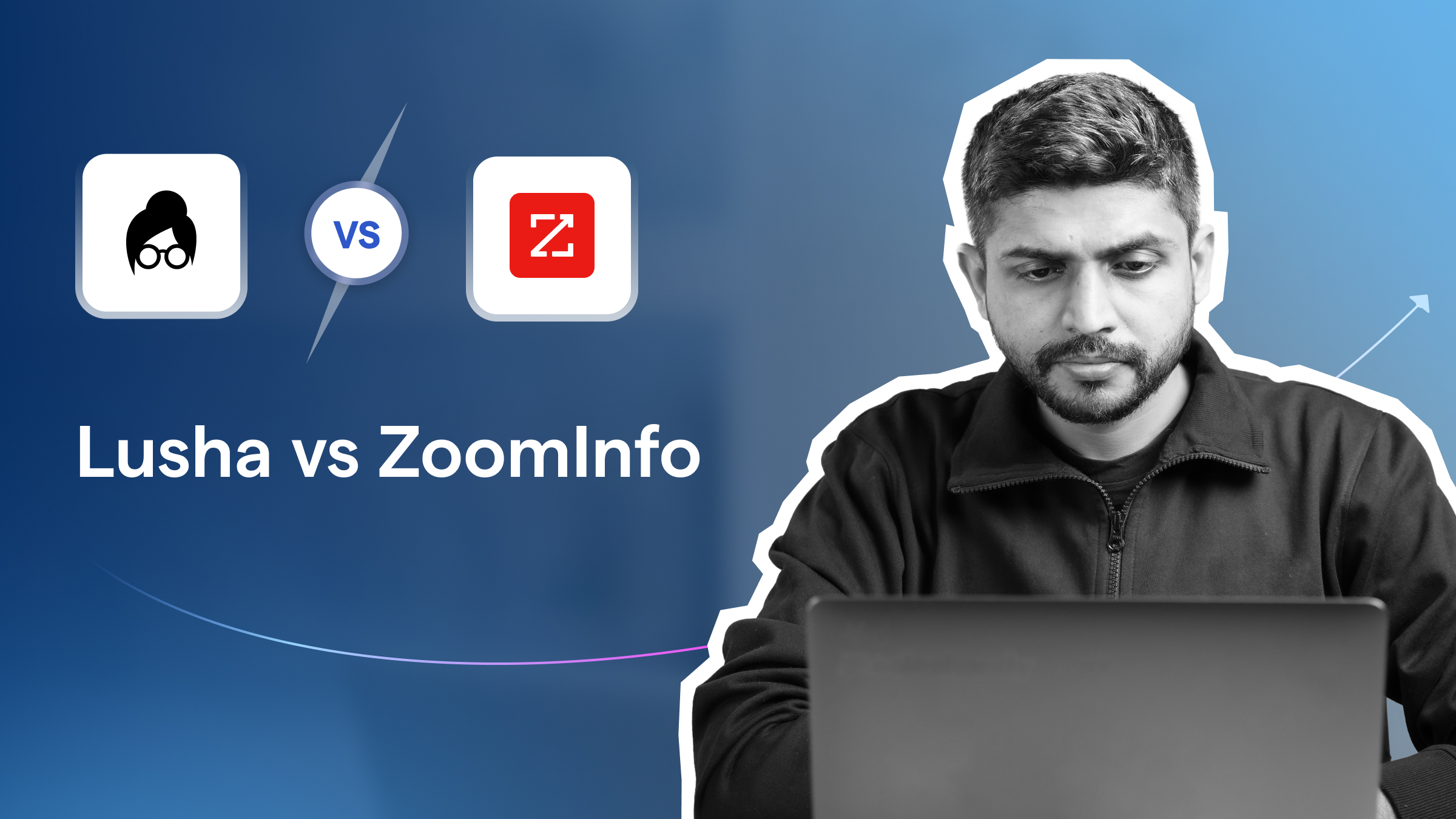Contents
- 1 Cold Emailing to C-Level Executives — TOC
- 2 An Example of Perfect and Worse Cold Email to C-Level Executives
- 3 How to Write a Cold Email to a C-Level Executive?
- 4 Cold Email Template for C-Level Executives
- 5 What C-Level Executives Look For in a Cold Email
- 6 What NOT to Do When Cold Emailing a C-Level Executive
- 7 4 Metrics to Track and Optimize for Better Responses
- 8 Final Thoughts (CEO’s Takeaway)
- 9 FAQs About Cold Emailing to C-Level Executives
Frustrated by sending cold emails to C-level executives and hearing… nothing?
You’ve tried different approaches, changing your messaging and testing subject lines, but still have no luck.
What if the issue isn’t just your email?
There could be other reasons:
- Are you targeting the right C-level executives?
- Is your lead data inaccurate?
- Is your cold email messaging off?
- Or maybe you’re not using the right cold email tool?
Chances are, it’s a mix of all these reasons.
That makes it even tougher to figure out how to reach decision-makers through cold email. And actually get replies.
After years in the cold emailing industry, testing, failing, and figuring out what works, I’ve created a framework that gets replies from C-level executives.
Quick answer: I’ve included examples of both a perfect cold email and a terrible one right after the introduction, so you’ll know exactly what works (and what doesn’t). Click here to jump to that section.
In this guide, I’ll explain everything from writing the right message to using the best tools so you can finally send cold emails to C-level executives and generate responses (eventually, revenue for your business).
Cold Emailing to C-Level Executives — TOC
- An Example of Perfect and Worse Cold Email to C-Level Executives
- How to Write a Cold Email to a C-Level Executive
- Cold Email Template for C-Level Executives
- What C-Level Executives Look For in a Cold Email
- What NOT to Do When Cold Emailing a C-Level Executive
- 4 Metrics to Track and Optimize for Better Responses
- Final Thoughts (CEO’s Takeaway)
- FAQs About Cold Emailing to C-Level Executives
An Example of Perfect and Worse Cold Email to C-Level Executives
In this section, I’ve shared two cold email examples, one good and one bad, to show you what works and what doesn’t for decision-makers.
Here is an example of a perfect cold email.
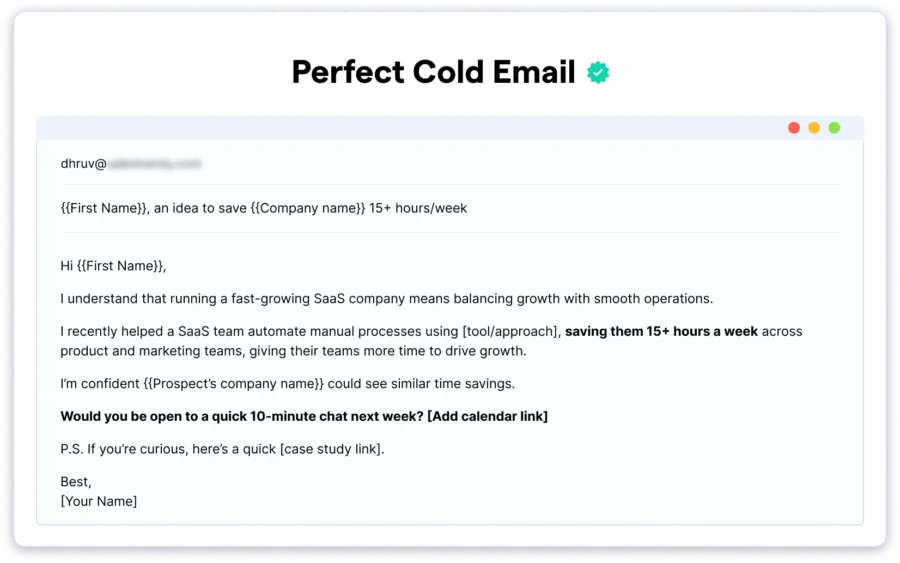
Now, let’s see an example of a worse cold email.

Did you notice the difference?
Both emails are completely different. Now, let’s move to the next section to learn how to write the perfect cold email for key stakeholders.
How to Write a Cold Email to a C-Level Executive?
What would be your first step in cold emailing? Pause for a moment and think about it.
Your answer would be finding the right leads and choosing the right cold emailing software. These two things are the utmost factors, but you are missing one more point.
That point is learning about your target audience or each prospect before sending cold emails. You must know about your audience, at least about their company, work, revenue, or a few things.
Does that seem overwhelming?
Don’t worry. I’ve explained this in detail in the first step.
- Know About C-Level Executives and Their Company Well
- Write a Subject Line That Grabs Attention
- Keep Your Opening Line Personal
- Add Value Proposition in Your Email
- Add a Call to Action with Clear Steps
- Best Time to Send Cold Emails
- Follow-Up Strategy
1. Know About C-Level Executives and Their Company Well
Learn about your audience. You’ve probably heard this advice many times.
But have you actually tried it? And do you understand why it matters? (Read ahead)
All of us know that to reach your target audience’s inboxes, you must have their email addresses. (This is very basic, but there is something you are missing)
Focus on a single industry when building a targeted email list. (Don’t target leaders from multiple industries at once)
P.S.: You can use Saleshandy’s B2B Lead Finder to build a highly targeted list of your ideal prospects in minutes. The best part? It allows you to extract 10,000 leads in one go.
Why? I’ll explain the reason.
Because you can’t properly personalize your email across different industries.
And if you try, your message will likely be too generic.
Here is what I mean by personalization. (It’s actually personalization)
Actually, you don’t JUST need to know only about business founders and executives, but you need to understand them properly.
(They are not like just other executives; C-level decision makers have very limited time, and they are leaders working to do meaningful things either for themselves, society, or industry)
- First, learn about the C-level executives. (Start from a small list of founders, maybe 15, 20, or 50 leads)
- Learn about each founder or decision-maker to identify the challenges they face within their organization.
- Follow their activities on social media platforms like LinkedIn to learn what interests them, identify pain points, and more.
Based on the information you find, combine all the pointers and take out the common pointers.
This helps you make your cold emails super personalized. You get an idea of what to write, how to write, and how to pitch your solution.
You can check out our article on how to personalize cold emails for better responses.
Once your basic research about your prospects is done, it’s time to work on subject lines.
2. Write a Subject Line That Grabs Attention
Ordinary subject lines get easily ignored.
Either you delete that email, mark it as read, or don’t even open it.
Ask yourself: As a marketer, sales professional, or lead generation specialist, would you open such emails with generic subject lines?
There is no chance that when you are busy with work and tight deadlines, you will check the generic emails in your inbox.
Unless you have too much free time to check emails all day. (Jokes apart..)
You will find that C-level executives will have tons of things on their plate when compared to you.
Do YOU think they will open an email (specifically a cold email) that has landed in their inboxes?
No, right?
That’s why I’m saying the subject line matters; it either makes or breaks your cold email game.
Let me share an example of how to write attention-grabbing cold email subject lines.
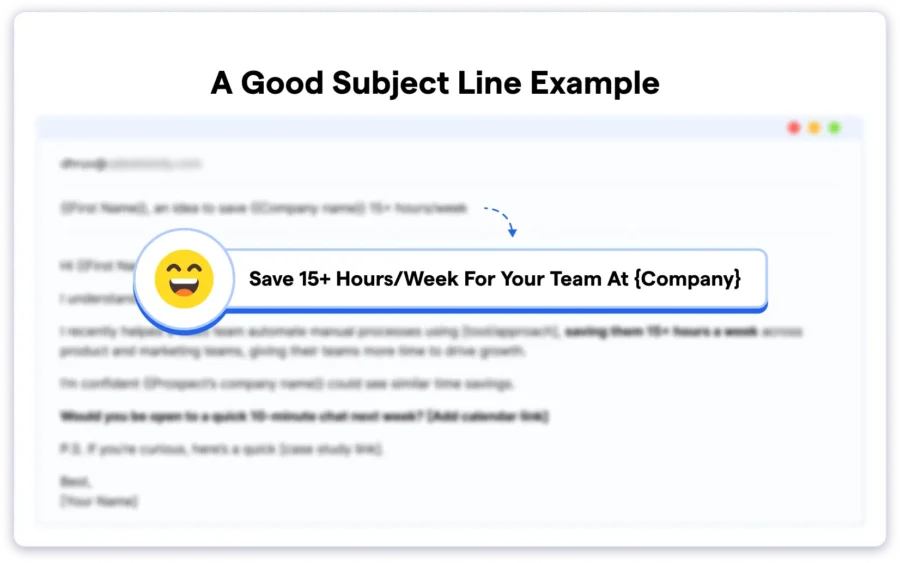
If you want to learn more about subject lines, here’s a resource with 100+ subject lines that improve open rate and response rate.
Further, let’s learn how to write an opening line.
3. Keep Your Opening Line Personal
Your first line of the email decides whether the recipient will read your entire email or not.
Your recipient will either read your email, skip back to their inbox, or save it to read later.
And we all know this. (Later means never; your email is valuable but couldn’t keep the reader engaged.)
The worst case is that your email gets deleted.
At this stage, I follow a personalization strategy that includes:
- Recent insights shared on platforms like LinkedIn
- Webinar stories they have participated or been mentioned
- Knowledge shared in their newsletter or on a third-party website
- Events attended that are relevant to their work or industry
Personalization works way better than you think if it’s done in the right way.
(Believe me, I’ve learned this from my personal experience)
4. Add Value Proposition in Your Email
As said, C-level executives don’t have time for vague pitches or fluff information.
To grab their attention, you need to be quick, concise, and clearly show how you can solve their specific problem.
Here are a few of the best approaches that have helped me when writing cold emails to decision-makers and getting replies.
- Make sure you focus on outcomes, not just become salesy.
That means you need to write what your solutions do for them. (C-level executives care for the end result)
- Tie the value to their business priorities.
For this point, you need to learn and understand what and why they care about it so you can connect directly with them.
- Keep your information clear and easy to understand.
Don’t use overly fancy wordings or technical jargon (until or unless you are reaching out to the Chief Technology Officers or C-level executives).
- Don’t make them think too much to understand your message.
Remember, they should be able to take quick action. (Too much thinking and analyzing leads to paralysis, which most C-level executives, even I don’t like)
- Add social proof to build trust.
To make them believe in you, the best approach is to add social proof, showcase a success story, and provide relevant results.
The next step is about adding a clear CTA.
5. Add a Call to Action with Clear Steps
Well, how do you close the deals or meetings booked in your cold emails?
A CTA helps, of course.
But… wait… not everybody knows how to write a CTA that ACTUALLY works and helps you book meetings or close deals.
Check this example of CTA.
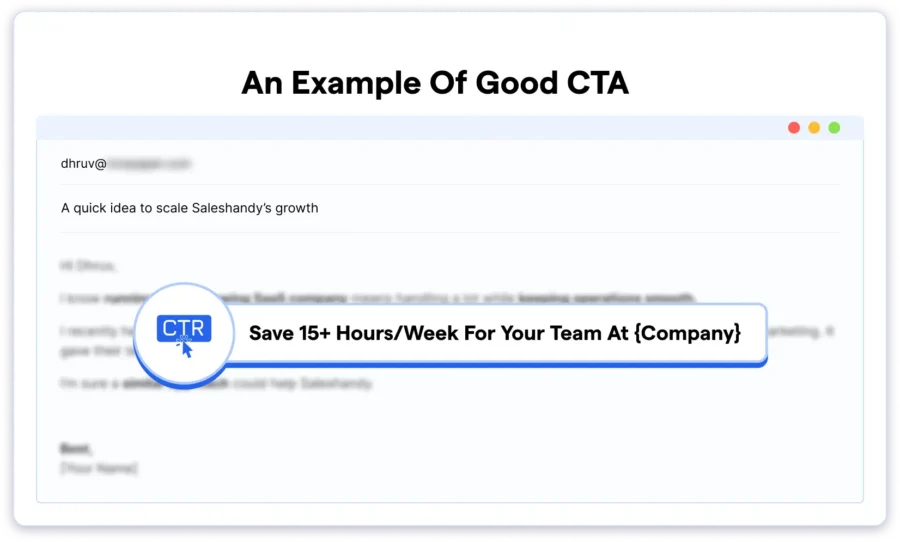
Writing a generic CTA in cold emails works if you are doing it for normal people. (Not for key stakeholders, sometimes) Then?
I’ve explained below how to end cold emails.
- You need to be direct. Tell them exactly what you want, whether it’s a quick call, a meeting next week, or a reply.
- You have to make it easy. Offer a simple next step, such as, “Would you be open to a 10-minute call next Tuesday at 2 PM?”
- You have to give them control. Respect their time by suggesting options, like, “Let me know if this aligns with your schedule.”
Most importantly, you need to avoid weak and open-ended CTAs. Such CTAs put the ball in their court, and if you are lucky, it works. Otherwise, in most cases, it doesn’t.
This way, you need to make it easy for a C-level executive to respond, and the better your chances of getting a reply.
If you want to learn how to write a CTA to book meetings, read this guide that includes over 100 examples of CTAs.
6. Best Time to Send Cold Emails
Timing matters a lot. (I’m saying this from my experience)
Why? The point is even the best cold email will go unnoticed if you send it at the wrong time.
When it comes to cold emails, timing isn’t just a minor detail. It can make or break your response rate.
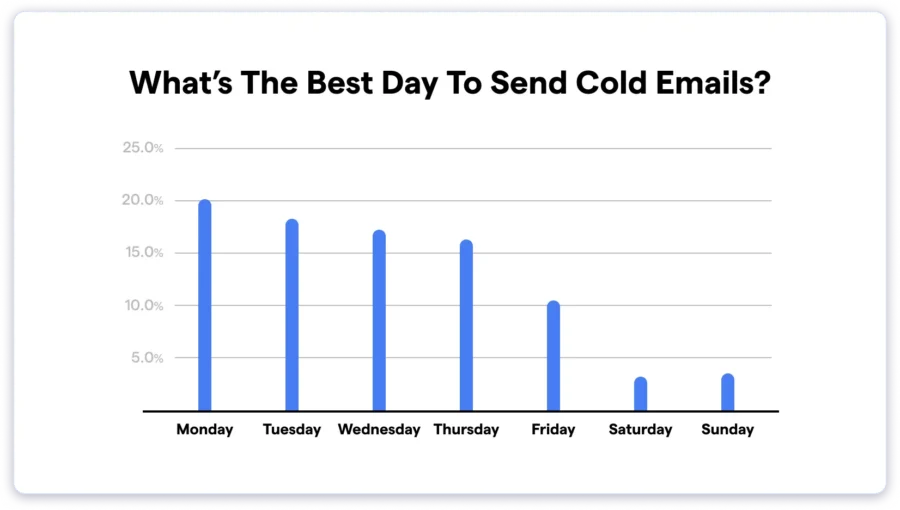
If you’re emailing C-level executives, you can’t afford to send emails when they’re buried under meetings or drowning in their inboxes.
You need to hit their inbox when they’re actually checking it.
Here are the best days to send cold emails stick to the workweek, but not just any day:
- Tuesday and Thursday: These are your golden days. Open, click, and reply rates peak here because inboxes aren’t as flooded as on Monday.
- Monday: Decent but risky. People are catching up from the weekend, and your email could get lost.
- Friday: Works if your goal is to start conversations, but decision-making? Unlikely.
You need to avoid weekends because no one checks work emails on Saturday or Sunday.
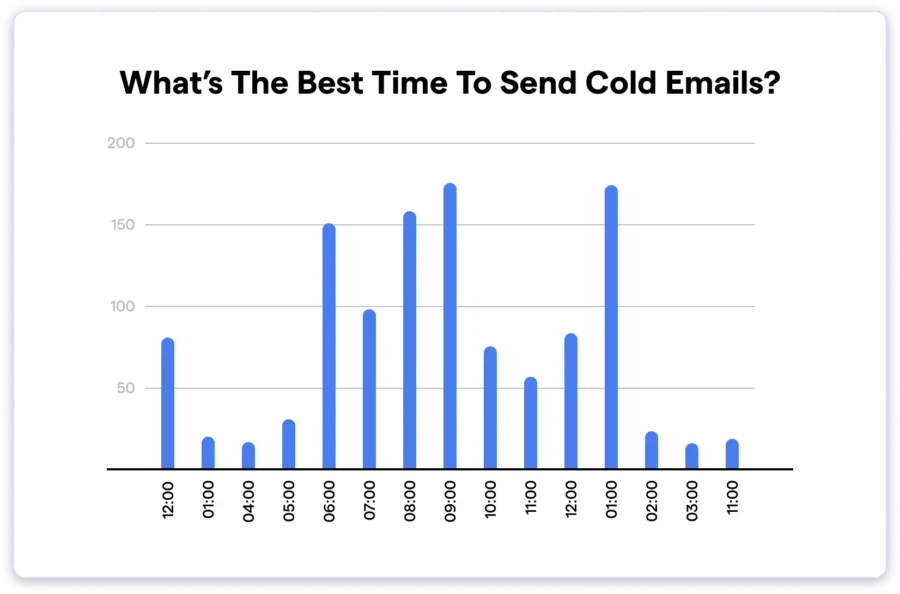
Here is the best time of day to send cold emails.
- 6 AM – 9 AM: Prime time. Most execs check emails first thing in the morning. This is your best shot at grabbing their attention.
- 12 PM – 2 PM: Lunch breaks work, too, especially for quick reads while they are free.
Avoid late afternoons and evenings: By then, they’re either in back-to-back meetings or mentally checked out.
→ Saleshandy automates follow-ups to help you get more replies. You can create personalized and multi-stage email sequences that adjust based on your prospect’s actions. With time-zone-based scheduling, your emails reach prospects at the right time, increasing engagement.
7. Follow-Up Strategy
You will be lucky if you get a response to the very first cold email from a key stakeholder.
However, the case is not the same every time.
You have to have sent multiple follow-ups to get a response from C-level executives.
Because they’re busy, their inbox is full, and your email is probably not their top priority.
Here’s how I handle follow-ups when I want to get a reply.
1. Timing: When to Send Follow-Ups
If you follow up too soon, it’s annoying. If you wait too long, they’ll forget you. You need to wait 3-5 days before following up.
Here’s how I do it:
- First follow-up: 3 days after the first email.
- Second follow-up: 5-7 days after the first follow-up.
- Third (final) follow-up: 1 week after the second follow-up.
If you have a question, why? Read these two pointers.
- It’s not too soon. C-level executives are busy, and they need time to check emails.
- It’s not too late. You stay fresh in their mind without being pushy.
2. Content: What to Say in Follow-Ups
When I follow up, I keep my message short and clear. No long explanations. I remind them why I reached out and how it can help their business.
Here’s a simple follow-up that works:
“Hi [Name], I wanted to check in and see if you had a chance to review my last email. I believe [your solution] can help with [specific business goal]. Let me know if you’d be open to a quick chat.”
Let me explain why here.
- It’s easy to read. No one wants to open a long email.
- It gives a reason to respond. You’re reminding them what’s in it for them.
3. Personalization: Make It About Their Business
If your follow-ups feel like a copy-paste message, they won’t get a reply.
What works better? Mention something specific about their company or goals. This shows you’re paying attention.
Here’s how I personalize follow-ups:
- Mention a recent change in their company (new product launch, expansion).
- Refer to a challenge you know they face (hiring, scaling, revenue growth).
- Share a similar company’s success using your solution.
Example: “Hi [Name], I noticed your company is expanding into new markets. We recently helped a similar company speed up its sales outreach. I’d love to share how we did it—let me know if you’re open to a quick conversation.”
Here’s why you need to personalize your follow-ups.
- It feels personal. You’re talking about their business, not just selling.
- It’s relevant. You’re connecting your solution to their current needs.
4. Frequency: How Many Follow-Ups to Send
I don’t send endless follow-ups; maybe 3 or 4 emails are the perfect spot.
After that, it’s better to move on. If they don’t respond after 3-4 attempts, they’re probably not interested. Check this image to learn about the follow-up strategy to follow.

Here’s my follow-up plan:
- First follow-up: 3 days later.
- Second follow-up: 5-7 days after that.
- Third (final) follow-up: 1 week later.
If there’s still no reply, I end things politely.
Example: “Hey [Name], I know things are busy, so I won’t follow up again. If this becomes a priority later, feel free to reach out. I’m happy to connect anytime.”
Why?
- It’s professional. You’re leaving on a positive note.
- It leaves the door open. If their priorities change, they know how to find you.
When you follow this approach, you’re not just another email in the inbox.
You’re someone who understands their time is valuable, and that makes a difference.
Cold Email Template for C-Level Executives
In this section, I’ve listed a few of the best cold email templates that you can directly use. Just a copy-paste, and you’re ready.
Cold Email Template: Initial Outreach
Subject: Struggling with {Pain Point}?
Hey {First Name},
I’m guessing your {department} team is dealing with {pain point}—it’s a common challenge, and it can slow things down fast.
I’m {Sender Name} from {Sender’s Company}. We’ve helped companies like {Client Company Names} tackle this exact issue using our {Product/Service}, and the results have been game-changing—fewer headaches, more growth.
I know you’ve got a lot on your plate, but if you’re open to it, I’d love to set up a quick call to share how we could help you solve {pain point} for good.
What do you say?
Cheers,
{Sender Name}
Cold Email Template: Scaling Opportunity
Subject: Ready to Scale {Prospect’s Company Name}?
Hi {prospect’s first name},
I’ll keep this short—I’ve got an idea that could help {prospect’s company name} hit {target goal} in just {time frame}, and it’ll only take 10 minutes to explain.
We recently helped {another customer’s name} from {customer’s company name} achieve {target goal} in {time frame} using {product name}, and I’m confident we can do the same for you.
Curious to hear how?
If you’re open to it, just let me know a couple of times that work, and we’ll set up a quick call.
Best,
{sender name}
Cold Email Template: Success Story
Subject: We Helped {Customer’s Name} Hit {Business Target}; You Could be Next
Hi {Prospect’s Name},
I know {pain point} can be frustrating, but it doesn’t have to be.
We recently helped {customer’s name} reach {business target} in just {time frame} with our {product/service}, and I’m confident we can do something similar for you.
If you’re open to it, I’d love to set up a quick chat to show you how we’re making {pain point} easier to handle (or even eliminating it entirely).
Worth a conversation?
Best,
{sender name}
Let’s now learn about the aspects that a C-level executive checks in a cold email.
What C-Level Executives Look For in a Cold Email
First, when a C-level executive opens a cold email, they want to know one thing:
Is this cold email worth my time?
Because they don’t have time to read long, confusing, or vague email pitches.
A top-level executive skims through the information mentioned in your cold email.
If you want a response, you need to be clear, relevant, and quick.
- Clear and Specific Information (No Guesswork)
- Personalization That Goes Beyond the Basics
- A Clear and Immediate Value Proposition
- A Clear Call to Action
- Proof That You’re Worth of Your Prospect’s Time
1. Clear and Specific Information (No Guesswork)
I don’t want vague promises or confusing pitches. Be direct and tell me exactly what you do and how it fits my business. If I have to figure it out myself, I’ll delete the email.
Instead of being generic, follow these pointers.
- A sharp opening line that explains the core problem you solve.
- Specific outcomes, not vague benefits (“We help SaaS companies cut acquisition costs by 25% in 90 days”).
- If you’re offering a solution, name it; you don’t need to repeat the entire email.
Tip: Lead with facts or outcomes.
“We recently helped [Company X] reduce churn by 18%, and I noticed similar patterns in your product model. Would you be open to a quick chat to explore if we can do the same for you?”
2. Personalization That Goes Beyond the Basics
Just copy-pasting name, company name, or designation doesn’t mean personalization.
What can get the attention of your C-level prospect?
When you really research your potential prospects, you demonstrate that you understand your prospect’s business priorities and current challenges.
You need to do these things.
- Reference specific initiatives like a new product launch or a recent funding round.
- Address pain points that your prospect is likely facing based on industry and role.
- Connect your offering to a strategic priority like increasing market share or improving operational efficiency.
Tip: Mention a relevant challenge my company might be facing, backed by data.
“I noticed your team recently expanded to new regions, and many SaaS companies struggle with maintaining sales efficiency during growth. We’ve helped others solve this, and I’d love to share how.”
3. A Clear and Immediate Value Proposition
I don’t care about features; I care about results. (It’s a motto of every top-level executive)
What impact will your product or service have on my bottom line, efficiency, or long-term growth?
Make it obvious why your C-level prospect should pay attention.
There are three things that can help you to add value propositions.
(After reading these pointers, you won’t need to search for value or get stuck in an endless loop of figuring out your value proposition)
- Outcome-first messaging: tell the result, not just what you do.
- You need to add quantifiable value to your cold email (Increase outbound efficiency by 30% without adding headcount).
- Focus on solving high-priority problems like revenue growth, cost reduction, or faster execution.
Tip: Think from the mindset of key stakeholders and be in their shoes to actually frame a value proposition. This perspective helps you to know how to solve a critical pain point.
4. A Clear Call to Action
If you are making it hard for C-level executives, you’ll fail. Don’t ask C-level executives to figure out the next step.
If you want to have a meeting or call, you have to provide clear steps to top-level executives.
I would prefer to provide a clear and easy-to-follow option that has no or minimal commitment to having a call.
A few of the examples that I follow are to keep a clear call to action button in the cold emails.
- Suggest a short and specific meeting window (Does a 10-minute call next Tuesday work?).
- Offer a non-committal option like a case study or a quick demo video.
- Make it easy to say yes, and avoid long forms or heavy steps.
Example: “If you’re open, I can share a 3-minute video showing exactly how this works. Just reply ‘Yes,’ and I’ll send it over.”
5. Proof That You’re Worth of Your Prospect’s Time
You need to show in your cold emails that you are not just talking.
That means you have to add proof that you’ve delivered to previously worked clients like mine.
Check the following pointers to learn to show that you’re worth my time.
- Mention specific companies I’d recognize and the outcomes you’ve achieved.
- Share measurable success (“We helped a competitor reduce acquisition costs by 22% in six months”).
- Keep it relevant by mentioning examples that are aligned with my industry or business model.
Example: “We recently worked with [Competitor] and reduced their customer onboarding time by 40%, which helped them scale without hiring more staff.”
What NOT to Do When Cold Emailing a C-Level Executive
When contacting C-level executives, the most minor mistakes can make your email get ignored or, worse, deleted.
If you really want to grab their attention with your cold email, here are a few things you should never do when cold emailing them.
- Don’t Write Long and Wordy Emails
- Avoid Generic or Copy-Paste Messages
- Make It About Them (Not You)
- Don’t Over-Follow-Up
1. Don’t Write Long and Wordy Emails
C-level executives are always busy, filled with a lot of work, and super busy at work. They don’t have time to read long emails. If your message feels like a wall of text, they’ll skip it.
What I do instead:
- Keep it short by writing only 2-3 short paragraphs max.
- Get to the point in the first two sentences.
- Use simple language, and no need to use any technical jargon or fluff.
Here’s a simple example of the wrong and right approach.
❌ Wrong approach: “I’m reaching out because our company offers a wide range of innovative solutions designed to optimize your sales processes and enhance productivity across multiple departments.”
✅ Better approach: “I help companies like yours speed up sales outreach. Let me know if you’re available for a quick chat.”
2. Avoid Generic or Copy-Paste Messages
Remember, C-level executives don’t like cold emails if you send a generic message. You are wasting your effort, resources, and time.
C-level executives get a sense of an email’s content from its very first line or subject line.
If it looks like you sent the same email to 50 others, they won’t respond.
What I do instead:
- Personalize each email with details about the company.
- Mention a recent event (funding, product launch, webinars).
- Customize your cold email content to their business goals or challenges.
❌ Wrong approach: “Hi, I’m reaching out because our solution could benefit your company.”
✅ Better approach: “Hi [Name], your team recently expanded into new markets. We help companies scale outreach without losing touch with potential leads. Would you be open to a quick chat?”
3. Make It About Them (Not You)
Believe it or not, C-level executives don’t have time for your emotions, and they actually don’t care about your product’s features.
Unless you’ve built a product like ChatGPT, Claude, Midjourney, or Cognition AI. (Products that have revolutionized the entire IT industry)
They only care about how it helps their business. (A bitter truth, but businesses work like this only)
If your email is all about you, they’ll lose interest.
What I do instead:
- Research and mention about their challenges (revenue, growth, efficiency).
- Show how you can help solve a specific problem.
- Mention results you’ve delivered for similar companies.
❌ Wrong approach: “Our tool has advanced AI and powerful automation features.”
✅ Better approach: “I can help your team save hours on manual outreach and connect with high-value leads fast. Are you open to learning more?”
4. Don’t Over-Follow-Up
Following up is important, but too many emails will annoy busy executives. If they don’t respond after several attempts, it’s time to back off.
What I do instead:
- Send 3-4 follow-ups max, spaced 3-7 days apart.
- Add value to each follow-up; don’t just ask if they saw your last email.
- Know when to stop and end the conversation politely.
❌ Wrong approach: “Just checking if you saw my email. Let me know.” (Sent 5 times)
✅ Better approach (final email): “Hey [Name], I know things are busy. I’ll pause here, but if this becomes a priority later, I’m happy to connect. I wish you success!”
When you avoid these mistakes, your cold emails feel more professional, personal, and worth a reply.
4 Metrics to Track and Optimize for Better Responses
If you want more people to respond to your cold emails, you need to track the right metrics. If you ask me, I track four key metrics that tell me what’s working and what’s not. Let’s start with the first, which is the reply rate.
- Reply Rate (How Many People Respond)
- Click-Through Rate (CTR – Who Clicks My Links)
- Bounce Rate (Emails That Don’t Go Through)
- Meeting Book Rate (How Many People Book a Meeting)
1. Reply Rate (How Many People Respond)
A reply rate metric tells me how many people reply to my emails. If no one responds, that means something is wrong and needs to be changed.
So, while measuring the replying rate, here is what I look for.
- How many emails I send vs. how many replies I get
- Whether the replies are positive, negative, or neutral
What’s my next move to improve reply rates?
I figure out whether my cold emails lack personalization, provide value, connect, and address a particular aspect or multiple aspects that aren’t working.
Afterward, I also tried A/B testing, which helped me try different subject lines, email content, and levels of personalization.
Do you want to learn more about it? Here is a detailed article on A/B testing in cold emailing.
Based on industry standards, if you ask me about a good reply rate, then it’s 8.5%, which means at least 8 out of 10 replies to your cold emails.
2. Click-Through Rate (CTR – Who Clicks My Links)
CTR simply means knowing how many of your prospects actually click on the link you added to your cold email.
For example, If I add a link (like a calendar to book a meeting), then this metric shows me how many people actually clicked on it.
So, this is what I look for or pay attention to:
- How many people click the link in my email
- Which links and emails get the most clicks out of the different cold emails I’ve sent
Based on the figure, here are the next steps I will take to improve it.
You need to place clear buttons or links instead of writing vague or unclear phrases.
Don’t add too many buttons or links.
You need to place links or CTAs, but before placing them, think and then do it.
Studies have shown that a good CTA ranges between 42%, which means my cold email is interesting to these percentages of people.
3. Bounce Rate (Emails That Don’t Go Through)
Have you ever thought, what if you get bounced meanwhile you are waiting for replies?
It is important to check and track this metric constantly during cold emailing to determine if an email “bounces,” which means it never reaches the person’s inbox.
However, the reasons for email bouncing could be if the email address is wrong or inactive.
Here is what I track to understand this metric.
- How many emails bounce vs. how many are delivered
- Whether the bounce is permanent (wrong email) or temporary (inbox full)
So, here is what I do to resolve the issue of bounce rate.
I use email verification tools to find and remove bad email addresses.
I start sending emails in small batches regularly to keep my email accounts or domains out of spam folders.
I regularly check email addresses that are outdated or invalid.
As per the latest statistics, you should keep the bounce rate between 2 to 5% to achieve better email deliverability.
4. Meeting Book Rate (How Many People Book a Meeting)
An ultimate goal for cold emailing is getting people to schedule a call or meeting with you.
So, the meeting book rate metrics determine how many people actually book a meeting or a call with you.
To calculate this, you need to check.
- How many people book a meeting vs how many emails you have sent
- Which emails or follow-ups help you get the most bookings?
To improve this metric for your cold emailing campaign, you need to follow the below pointers.
- Make sure scheduling a meeting is easy by placing a clear link to the calendar.
- You need to reach only the right audience from whom you actually get benefits.
- You need to send multiple follow-ups a couple of times to get and check in again for better responses.
→ Saleshandy provides in-depth tracking to help you measure and improve your cold email performance. It tracks key metrics like email opens, link clicks, replies, and bounce rates by providing you with real-time insights into how your campaigns are performing.
Final Thoughts (CEO’s Takeaway)
In a nutshell, cold emailing C-level executives is about clarity, relevance, and value.
Here are the key takeaways to get it right:
- Be concise and direct: C-level executives are busy, so get to the point quickly.
- Personalize with purpose: Show you understand their business challenges and how you can solve them.
- Focus on value: Showcase the specific outcomes or benefits your solution brings to their organization.
- Respect their time: Make your message easy to read and actionable, and it doesn’t have fluff.
When you prioritize value over volume and relevance over reach, you’re not just sending another email. You’re starting a conversation that matters.
With Saleshandy, you can make this process easy and fast. How?
It helps you personalize your emails, track how executives engage, and improve your chances of landing in their inbox.
Ready to get a trial? Take a 7-day trial of Saleshandy to get started.
FAQs About Cold Emailing to C-Level Executives
1. How do you bypass gatekeepers when cold emailing C-level executives?
Be polite and clear about the value you bring. If the gatekeeper is tough, try reaching the executive through LinkedIn or by finding their direct email using lead tools.
2. How do you make your email stand out to a C-level executive?
Start with a strong and personalized hook. Mention something specific, like a recent project, an interview, or a company achievement. Keep your message short and focused on how you can solve a problem they care about.
3. What kind of tone works best when emailing C-level executives?
Be professional but conversational. Skip the fluff and focus on how you can make their life easier or business better. They’re busy, so get to the point quickly.
4. What tools can help improve cold emailing to C-level executives?
The right tools make cold emailing easy for everybody. Email verification ensures you’re reaching valid addresses, while tracking tools help you time follow-ups based on opens and clicks. Platforms like Saleshandy combine these with personalization and automated follow-ups, helping you connect with C-level executives and the rest of the people holding different designations.







